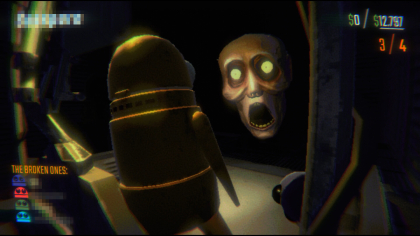Digital Odyssey: Unveiling the Layers of R.E.P.O. Game
My First Encounter
When I first booted up R.E.P.O. Game, I was instantly struck by its enigmatic interface and the promise of an immersive experience that would challenge both my creativity and strategic thinking. The title has a subtle allure that piqued my curiosity from the beginning and, as I delved deeper, I found myself completely absorbed in its multifaceted world. Each moment felt meticulously designed to stimulate thoughtful engagement and to invite me to explore beyond the obvious. My initial interactions with the title set the stage for an adventure that would, in many ways, redefine the boundaries of interactive entertainment.
Exploring the Intricate Narrative
The storyline in R.E.P.O. Game is far from conventional. I discovered a narrative layered with mystery, symbolism, and unexpected twists that kept me invested in the unfolding drama. The game avoids cliched tropes by blending elements of science fiction with subtle hints of surrealism, crafting a narrative that feels both personal and expansive. As I progressed, I found that every character and subplot was woven with care, evoking emotions that ranged from excitement to solemn introspection. The narrative does not hand me all the details on a silver platter; instead, it encourages me to piece together clues from the environment, conversations, and hidden lore scattered throughout the game world.
Innovative Gameplay Dynamics
Gameplay mechanics in R.E.P.O. Game are designed to challenge my preconceptions of what interactive storytelling can achieve. I’m particularly impressed with how the game seamlessly integrates puzzle-solving elements with action-based scenarios. The challenges presented are not just a test of reflexes but also an exercise in critical thinking and strategy. I found that every action, be it solving an environmental puzzle or engaging in a dynamic confrontation, was accompanied by a sense of purpose and precision. The controls are surprisingly fluid, which allowed me to focus on solving complex challenges rather than grappling with unresponsive mechanisms.
Immersive World Building
One of the most captivating aspects of R.E.P.O. Game is its ability to build a world that feels both vast and intimately detailed. As I roamed through meticulously designed landscapes, I was constantly in awe of the rich environments that ranged from futuristic urban sprawls to desolate, dreamlike wastelands. Each setting is imbued with its own unique history, and I really enjoyed discovering hidden corners that told stories of a society long past. What I appreciate the most is the consistency in world design; every locale, whether bustling or abandoned, has a story to tell through both its visual cues and ambient sounds. This careful attention to detail enhances my feeling of immersion, making the digital experience feel almost tangible.
Artistic Aesthetics and Visual Style
The artistic direction of the game is nothing short of a masterclass in visual storytelling. I was immediately taken by the visual style that blends modern digital art with elements of classical design, creating a look that is both contemporary and reminiscent of older works of art. The color palette is thoughtfully chosen to evoke specific moods in different parts of the game. For example, cooler tones dominate the shadowy, mysterious sections of the world, while vibrant hues make the more dynamic scenes pop with life. The character designs are equally fascinating, with each figure exhibiting detailed animations and expressions that convey subtle emotional nuances. This level of artistic integrity significantly enriches my overall experience, leaving a lasting impression on me long after I paused the game.
Sound and Music Scoring
Sound plays a crucial role in fully realizing the atmosphere of R.E.P.O. Game, and I found the auditory experience exceptionally well-crafted. Every note of the background score seems to echo the game’s evolving themes of mystery and adventure. The ambient sounds are perfectly aligned with the visual elements, transforming even a simple walk in a virtual landscape into an emotionally charged journey. There were moments when quiet musical interludes made me feel as if I were privy to the secret whispers of the game’s hidden backstory. The meticulous sound design reinforces the gameplay and narrative, providing subtle hints that help me piece together the larger picture while also enhancing my emotional investment in the unfolding events.
Responsive Interface and Controls
The game’s interface is designed with clear functionality in mind, and I appreciate the level of thought put into making every interaction feel intuitively smooth. Navigating through the game menus and interfaces was a delight, as every command responded swiftly without any distracting lag. The developers clearly prioritized a user-friendly design, ensuring that even the most intricate features could be accessed without a steep learning curve. This fluidity greatly enhanced my gameplay experience, allowing me to concentrate on strategy and exploration rather than fumbling with awkward controls.
Engaging Multiplayer Atmosphere
While my journey in R.E.P.O. Game has been mostly a solitary one, I have to mention the intriguing multiplayer aspects that add further layers of interaction. When I first ventured into the multiplayer mode, I marveled at how it retained the game’s signature blend of strategy and narrative depth even when shared with other players. My interactions with fellow participants were cooperative yet competitive in a manner that encouraged both social interaction and personal growth. The dynamic challenges in multiplayer mode required me to communicate effectively and to adopt strategies that balanced individual skill with teamwork. This feature not only extended the game’s longevity but also deepened my appreciation for the creative ways the game designers have integrated community-driven elements.
Challenging Puzzle Elements
I found the puzzles in R.E.P.O. Game to be both intriguing and thoughtfully integrated into the overall gameplay. They are intricately linked to the game’s lore and serve as more than mere obstacles to progress. Each puzzle requires me to think outside the box and to draw connections between seemingly unrelated elements within the game world. It is clear that a significant amount of effort went into designing puzzles that are intellectually demanding, yet fair. I revel in the satisfaction that comes from slowly unlocking each riddle, and the gradual revelation of their secrets contributes greatly to my immersive experience. In particular, the environmental puzzles that require me to keenly observe visual cues helped me feel like a detective on the cusp of uncovering a hidden narrative layer.
Dynamic Character Progression
The game’s character progression system is notable for its depth and flexibility. I appreciated the freedom to shape my character’s skills and attributes based on my personal play style. Rather than forcing me down a narrow path, the game offers a variety of customization options that cater to diverse strategies and preferences. As I advanced, I was given the opportunity to unlock unique abilities that altered how I interacted with the game world. This adaptability not only made each play session unique but also encouraged me to experiment with different approaches. Whether I was focusing on a stealthy infiltration strategy or engaging in direct tactical maneuvers, the character progression system ensured that every decision resonated with the overarching mechanics of the game.
Enthralling In-Game Challenges
The in-game challenges in R.E.P.O. Game truly test my adaptability and patience. I often found myself in scenarios that required split-second decisions mixed with long-term planning. Jumping into these challenges, I was met with situations that demanded not just strategy but a deep understanding of the game’s rich background. Each challenge feels like an organic extension of the storyline rather than a mere obstacle. There are moments when the pressure of a high-stakes encounter brings a sense of urgency and responsibility, and my heart raced with a mix of anticipation and cautious optimism. I appreciated that the difficulty scaling was well-calibrated; the early challenges helped me ease into the game’s mechanics, while later segments truly pushed the limits of my problem-solving skills.
Replay Value and Content Depth
What has truly kept me coming back to R.E.P.O. Game is its impressive replayability. The game is designed in layers that consistently reveal new content with every playthrough. There are countless hidden paths and secret rooms that I discovered after multiple sessions. This layered content structure means that even after spending considerable time in the game, I’m still eager to return and unearth additional mysteries that were previously concealed. The developers have infused the gameplay with a sense of dynamic unpredictability, ensuring that I am never truly aware of what might lie around the next corner. This thoughtful design encourages me to engage with different aspects of the game, further exploring alternative strategies and outcomes.
Technical Robustness and Stability
From a technical standpoint, R.E.P.O. Game impressed me with its smooth performance and rock-solid stability. I experienced minimal glitches and rare instances of unresponsive moments, which is a testament to the rigorous testing and effort put in by the developers. The game’s performance remains consistent across different devices and graphical settings, which speaks volumes about its optimization. I appreciated how the graphics rendered flawlessly even during the most demanding sequences, and loading times were kept short enough to maintain a steady rhythm in gameplay. This technical robustness allowed me to immerse myself in the experience without the distraction of technical interruptions.
Community-Driven Enhancements and Regular Updates
One of the most exciting aspects for me has been the developers' commitment to community feedback and continuous improvement. Whether it’s through new content updates, bug fixes, or additional game modes, R.E.P.O. Game has evolved significantly since its release. I have been part of numerous online discussions, and it is clear that the game’s community is both passionate and closely involved with the development process. The frequent updates not only introduce fresh challenges but also integrate new artistic elements and gameplay mechanics inspired by community suggestions. Being a part of this evolving ecosystem makes me feel appreciated as a player, and it reinforces my engagement with a game that is constantly refining its identity.
Exploration of Hidden Mechanics
As I journeyed further into the intricate layers of R.E.P.O. Game, I began to uncover hidden mechanics that added depth beyond the obvious gameplay. It took a keen eye and an inquisitive mind to discover these subtle features, which ranged from secret mini-missions to complex resource management systems rarely highlighted in the main narrative. I found joy in these discoveries, as they often provided a refreshing break from the main storyline while offering additional context and challenges. Learning about these concealed layers became a personal quest within the game, compelling me to experiment and explore alternative scenarios that I might otherwise have overlooked. Each discovery felt like a personal confession from the game itself, rewarding my curiosity with insights that gradually enriched my overall understanding.
Detailed Environmental Interactions
In R.E.P.O. Game, environmental interactions are a core element that I came to appreciate steadily. The ability to manipulate various objects and interact with the surroundings in a meaningful way is one of the features that truly set the game apart. Whether rearranging elements in a puzzle or triggering hidden events, the environment is never simply a backdrop; it’s an active participant in the storytelling. I was fascinated by the richness of these interactive details, which invited me to experiment with every nook and cranny. This mechanic not only added to the immersion but also encouraged me to observe and learn from the game’s design on a more granular level. Every change in the environment, every shift in lighting or color over time, contributed to an evolving narrative that reflected the passage of time within the game itself.
Engaging and Adaptive AI Opponents
One standout feature that caught my attention was the adaptive behavior of the AI opponents. The game’s artificial intelligence is designed not only to challenge my strategic thinking but also to react dynamically to my play style. I encountered opponents that adjusted their tactics based on my past actions, which raised the stakes and made each confrontation uniquely exciting. The adaptability of these opponents meant that I had to continuously refine my approach, preventing the gameplay from ever feeling static or monotonous. There were moments when I found myself outsmarted by the AI, and instead of feeling frustrated, I appreciated the lessons learned from that encounter. This dynamic responsiveness ensured that every game session offered fresh challenges and compelling opportunities to sharpen my skills.
To download the app, you will get links to the Official Website and/or official digital markets.




























